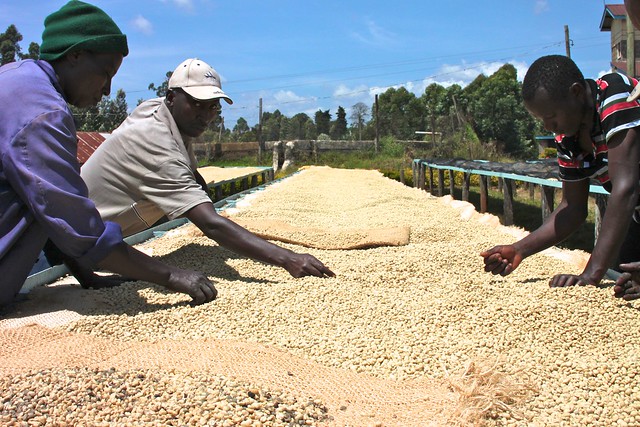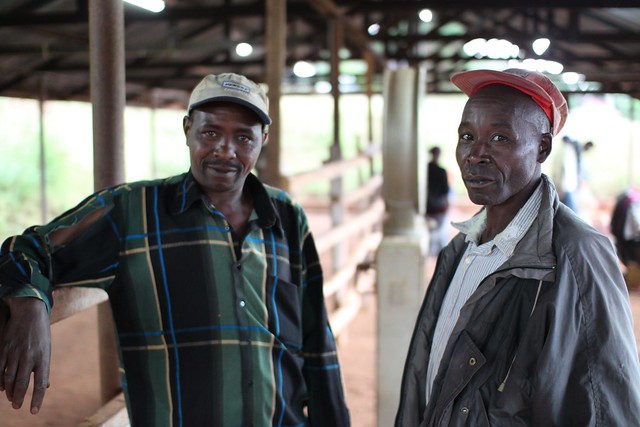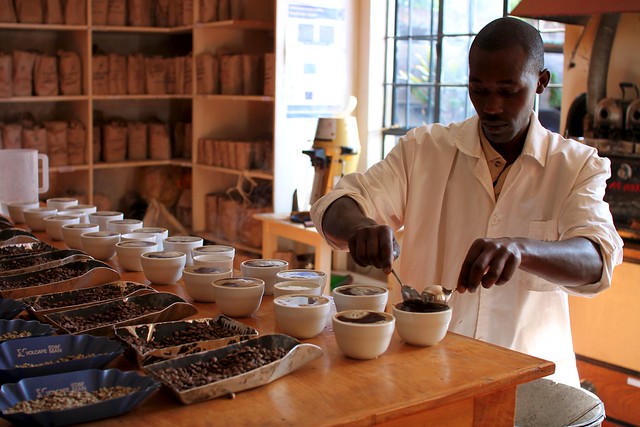Recently
returned from an 8 day trip to Kenya I will try to dot down a few thoughts
while they are fresh in my memory. I’ve decided to split this into two blog
posts. The first is a bit more general about how things work in Kenya, trying
to perhaps clear up some confusion that I’ve notice exict amongst both
consumers and baristas. I also wanted to touch on prices this year.
Structure
of farmers in Kenya
There’s
some confusing about the different names of coffees coming out of Kenya, so
I’ll try to explain it briefly.
Society
You might
have seen names like Mugaga, Tekangu and Gikanda on coffees. These are society
names. Each factory is a member of a society. In a lot of cases you can de-code
the society name. For example Gikanda is made up from Gichathaini, Kangocho and
Ndaroini. Tekangu is Tegu, Karogoto and Ngunguru. Mugaga is an exception to
this with Kieni, Gatina, Kiamambara and Kagumoini.
Factory
Factories
are wet mills. They’re just called factories in Kenya. This is where the
members, or smallholders as they’re also called, deliver their freshly picked
cherries. The factory manager decides when the members should pick. At some
factories it’s every week, others every 10 days. Each member is paid 50 ksh pr
kilo of cherry upfront and can even get an advance on their expected delivery
of cherry, if they have bills to pay before the harvest. After the coffee has
been sold the factory know how much they’ve earned, the profits are paid out to
the members. By law at least 80% has to be paid out to the members, so running
the factory can cost 20% at the most. New drying tables of repairs of machinery
will of course make it more expensive to run the factory, but a lot of the
better factories are only taking 10-15% of the profits. Last year the members
of Kieni was paid a total of 138 ksh pr kilo cherry. Please note that this is
cherry of all sizes and densities, and even though they are picked ripe there
will still be a lot to sort out. The price paid to farmers at Kieni was some of
the highest in Kenya last year.
Members
Typically
the factories we visited had between 600 and 1000 members. Each member is
typically a farmer and his family and can have anything from 40 up to several
hundred trees. Some of the larger members hire work for picking, and others
manage to pick their own trees themselves with help from the family.
It’s the
members that choose the board and chairman of the factory. In the Mugaga
society (and many other societies) the managers change between the factories
every two years.
We've decided to identify the coffees we buy with the factory name, as that's the most precise identification of where that particular coffee came from. Naturally, with 900 small farmers delivering cherry we can't identify further where it came from. If you would like to know more certain you can guess it's within an approximate 3 km radius of the factory.
Processing
The fresh
picked cherry is delivered at the factory, where each member’s amount is
weighed and they are given a receipt for final payment once the coffee is sold.
The cherries are then depulped and put into fermentation tanks. The cherries
are delivered in the afternoon and depulping is finished in the early evening.
The first fermentation goes on over night while it’s cooler and in the morning
the coffee is washed to remove most of the mucilage. It is then moved into a
second fermentation tank. Here it stays for 12 to 48 hours for the second
fermentation. After that the coffee is washed in channels with lots of clean
water to remove the last mucilage and ensure it is clean. Then the coffee is put
in soaking tanks for 10 to 18 hours before finally going to the drying tables.
At this
point the beans are around 50% moisture and over the course of approximately 10
days it is dried to around 11% moisture (10% if you count the parchement). It’s
important that the beans aren’t exposed to hard direct sun light, as they will
then crack from too fast drying. The rasied beds used in Kenya unsure good
airflow from underneath and turning the coffee often will help a uniform
drying.
Some mills
use a moisture meter to determine when the coffee has dried. But much like an
un-calibrated Extract Mojo this can be dangerous to trust. Properly calibrated
it can be a great tool though. Lots of millers will determine it by look and
feel, though, and can get it just as precise. After drying the coffee needs to
rest for about 2 weeks before it is delivered at the Dry Mill.


Central
Kenya Coffee Mill
This is our
hub for quality coffee from the central region in Kenya, including of course
Nyeri. The coffees we’ve cupped come through this mill and we like to do a lot
of cupping here. It means we can evaluate the coffees close to the facotories
and cup them as soon as they arrive.
At the dry
mill the coffee is hulled, sorted for size and density - AA, AB, C, PB, T, TT
and UG (Un.Graded), and finally sorted for defects. We pay an extra premium for
an additional hand sorting on top of the electronic sorting, as well as for
vacuum packing in stead of jute bags. All these costs are on top of the price
we pay directly to the farmers, on a separate contract to avoid any confusion.
Prices 2012
Last years
prices were at an all time high, due both to very high global market price, but
especially because of the unusual low harvest last year. Low supply and high
demand simple drew prices up.
This was
good news for farmers, who would otherwise (with a low harvest) have lost a lot
of money. In stead it turned out to be invigorating news for many smallholders.
Once again they could see that it can be profitable for them to produce coffee.
Many
farmers we talked to on the trip have told us that a few years ago they were
uprooting coffee trees and changing to other crops, like banana or maize. But
with last years high prices they feel that coffee can be a profitable crop and
more importantly young people can see a future in growing coffee. This of
course is significant for us as coffee roasters, and once again stresses why
roasters need to make sure that the farmers are paid well for their coffee.
This year
the prices will probably go down quite a bit. The harvest is more than double
of last year and there are lots of AAs (the largest size beans, which fetch a
higher price). I do hope prices won’t drop all the way back to what they used
to be a couple of years ago. Even though we paid a high price back then, it’ll
be a blow to the feeling of economic rise that the farmers have seen in the
horizon. On the other hand the price for the top lots last year, were so high
that many roasters didn’t feel that was sustainable for them as well. I believe
that we need to prepare our customers to pay that kind of prices for that kind
of quality. We cannot expect farmers to produce quality if consumers are not
willing to pay for it.
Pictures
You can view pictures (with titles and description on some) on a little Flickr slideshow here:



2 comments:
Lovely post, and lovely pictures. Welcome home!
Jake
This is very insightful. Thank you for taking the time to write this.
Post a Comment